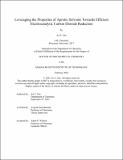Leveraging the Properties of Aprotic Solvents Towards Efficient Electrocatalytic Carbon Dioxide Reduction
Author(s)
Chu, An T.
DownloadThesis PDF (3.843Mb)
Advisor
Surendranath, Yogesh
Terms of use
Metadata
Show full item recordAbstract
Electrochemical carbon dioxide reduction has been studied as a method to sustainably produce valorized hydrocarbons. However, the reaction faces two challenges: low reaction selectivity towards value added products, and the deleterious reaction of carbon dioxide with the electrolyte to form soluble carbonate species. While both issues are sensitive to the composition of the electrolyte, the reaction has been exhaustively studied in aqueous electrolytes with limited opportunities for further extensive tunability. This thesis describes approaches for overcoming low reaction selectivity and electrolyte carbonation using aprotic-solvent based electrolytes. We leverage the unique solvation environments and equilibrium acidities accessible in such media to overcome key limitations to reaction performance that are intrinsically linked to the use of aqueous electrolytes. We demonstrate key principles for tuning aprotic solvent-based electrolytes towards improving carbon dioxide electroreduction catalysis, establishing the foundation for the development of advanced electrolyte designs.
Chapter 1 details the development of a dimethyl sulfoxide / acetic acid electrolyte which can engender selective carbon dioxide reduction with minimal electrolyte carbonation on gold cathodes. We demonstrate that the key to engendering these balance of properties entails operating an electrolyte with a low water content, with simultaneous usage of a buffer which is non-nucleophilic and whose pKa is matched to the carbon dioxide / bicarbonate equilibrium. Under such conditions, the selectivity to carbon monoxide can be driven as high as 90% with only millimolar equilibrium bicarbonate formation: a compromise difficult to achieve in water.
Chapter 2 details the discovery of a new mechanism for ethylene electrosynthesis on copper catalyst using dimethyl sulfoxide / phenol electrolyte. Starting from carbon monoxide—a crucial intermediate in the carbon dioxide reduction pathway—we present kinetic evidence that radically altering the solvent environment and proton donor can enable a mechanism involving quasi-equilibrium proton and electron transfer steps prior to a late rate-determining step. By demonstrating that the pathway in dimethyl sulfoxide / phenol has a potential-rate scaling and acid order distinct from those in aqueous electrolytes, we establish a new tunable platform for enabling selective electrocatalysis of hydrocarbon products.
Date issued
2024-02Department
Massachusetts Institute of Technology. Department of ChemistryPublisher
Massachusetts Institute of Technology